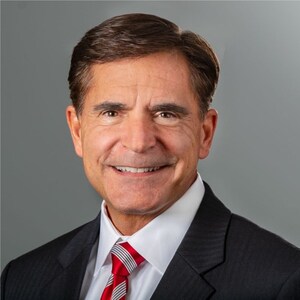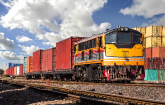Greenbrier Leads With Safer Tank Car Design
~ Will Engineer "Tank Car Of The Future" For Oil and Ethanol Service
~~ Offers Retrofit For Existing North American Tank Car Fleet
LAKE OSWEGO, Ore., Feb. 5, 2014 /PRNewswire/ -- The Greenbrier Companies ("Greenbrier"), (NYSE:GBX), announced today that it will design a new generation "Tank Car of the Future" for rail transport of hazardous freight, including flammable crude oil and ethanol, that can better withstand the additional demands associated with operating unit trains. The new "Tank Car of the Future" design will also respond to safety criticisms of the existing legacy fleet of older DOT-111 tank cars. The new car design is intended to meet anticipated new industry and government standards for tank cars transporting certain hazardous material. Greenbrier is also introducing retrofits for tank cars already in service or now being produced, significantly enhancing the safety of existing cars.
"Statistics from the Association of American Railroads ("AAR") show that 99.9977% of all rail-carried hazardous material arrives at its destination without incident. However, recent high-profile derailments have clearly demonstrated the need for updating the North American tank car fleet to the highest practical safety standards," said Greenbrier Chairman and CEO William Furman. "Greenbrier is addressing the tank car safety issue on two fronts - by supporting a 'Tank Car of the Future' and through offering retrofit alternatives for the legacy fleet, including our most recently built CPC-1232 tank cars, as may be appropriate. This allows the industry to take immediate steps to improve public safety. It also preserves the massive investment in tank cars now in service, by extending the time these cars could be used in hazardous material transportation as they ultimately transition over time to less hazardous service. The Department of Transportation ("DOT") has yet to rule on industry recommendations to adopt the newer and safer CPC-1232 standards submitted to them in March 2011. These were subsequently mandated by the AAR on tank cars ordered after October 2011. When Greenbrier builds railcars, our top priorities are to ensure our workers' and the public's safety while protecting the natural environment."
In order to respond to immediate safety concerns, and in anticipation of future action by the DOT, Greenbrier is also introducing retrofits for legacy DOT-111 cars and newer cars that meet the current CPC-1232 standard mandated by AAR. As of November 2013, there were 272,100 DOT-111 tank cars in service in North America of which 255,000 were of the older legacy design. Among those tank cars, 170,000 were in hazardous transport, with 68,000 tank cars in crude oil and ethanol service.
Retrofit options for the legacy DOT-111 tank cars will include high-flow pressure relief valves, head shields, top fittings protection and thermal protection. It is expected that appropriate retrofit choices could allow extended service for DOT-111 tank cars as these cars are placed in lower risk service over time. Industry research has shown that bottom and top appurtenances on the legacy DOT-111 tank cars are impacted in high speed derailments. Greenbrier's proposed retrofit is targeted to improve these tank car features, and adds head shields, to achieve better performance in a derailment event.
Greenbrier will also provide retrofit offerings for newer tank cars built under the AAR's CPC -1232 standards, which applies to all tank cars ordered after October 2011. Greenbrier's retrofit package for newer CPC-1232 cars includes high-flow pressure relief valves and improved bottom outlet valve handles for any CPC-1232 cars in crude and ethanol service which were not originally equipped with these features.
Combined, these retrofits can meaningfully improve the safety performance of both car types in continued service. Greenbrier expects its "Tank Car of the Future" and retrofit offerings will comply with anticipated Class I rail carrier requirements as well as pending regulatory actions by the U.S. and Canadian governments. The Company's retrofitting work, as part of its Wheels, Refurbishment & Parts segment, will not materially impact production rates for new builds as part of its Manufacturing segment.
Furman continued, "Greenbrier has a rich history of designing and building the world's most durable tank cars for delivering sensitive materials. For over 30 years our Wagony Swidnica facility in Poland has built all types of pressure tank and specialty cars for the Western European rail system. European tank car service is highly regulated, and typically consists of shorter, faster trains than in the US and North America, with many advanced safety features and an excellent safety record for hazardous materials service."
"We are prepared to respond in part as the result of an order to build 500 pressure cars in North America. Currently, pressure cars are used to transport hazardous freight other than crude oil and ethanol. These cars exceed current tank car standards for cars transporting crude oil and ethanol, as well as all new tank car standards recently considered by AAR. Our pressure car experience will aid our design effort on the Tank Car of the Future for non-pressurized hazardous service, including the transportation of crude oil and ethanol," Furman added.
In North America, Greenbrier can build tank cars at a rate of 4,000 cars per year, and is increasing its capacity in light of higher demand for tank cars related to the energy renaissance in America. As of November 30, 2013, 47% of Greenbrier's backlog consisted of tank cars which are almost entirely the more advanced and safer CPC-1232 tank cars and pressure cars. Greenbrier no longer produces the legacy DOT-111 tank car for use in flammable service.
Greenbrier will collaborate with industry leaders to achieve a shared goal of providing the safest means of transportation of crude oil and ethanol by rail. Railroads already have addressed operating practices to improve safety, while energy and chemical shippers are evaluating the content of their commodities to verify proper packaging to protect the public and the environment.
About Greenbrier Companies
Greenbrier (www.gbrx.com), headquartered in Lake Oswego, Oregon, is a leading supplier of transportation equipment and services to the railroad industry. Greenbrier builds new railroad freight cars in its four manufacturing facilities in the U.S. and Mexico and marine barges at its U.S. facility. It also repairs and refurbishes freight cars and provides wheels and railcar parts at 36 locations across North America. Greenbrier builds new railroad freight cars and refurbishes freight cars for the European market through both its operations in Poland and various subcontractor facilities throughout Europe. Greenbrier owns approximately 8,100 railcars, and performs management services for approximately 233,000 railcars.
"SAFE HARBOR" STATEMENT UNDER THE PRIVATE SECURITIES LITIGATION REFORM ACT OF 1995: This press release may contain forward-looking statements, including statements regarding expected new railcar production volumes and schedules, expected customer demand for the Company's products and services, plans to increase manufacturing capacity, restructuring plans, new railcar delivery volumes and schedules, growth in demand for the Company's railcar services and parts business, and the Company's future financial performance. Greenbrier uses words such as "anticipates," "believes," "forecast," "potential," "goal," "contemplates," "expects," "intends," "plans," "projects," "hopes," "seeks," "estimates," "could," "would," "will," "may," "can," "designed to," "foreseeable future" and similar expressions to identify forward-looking statements. These forward-looking statements are not guarantees of future performance and are subject to certain risks and uncertainties that could cause actual results to differ materially from in the results contemplated by the forward-looking statements. Factors that might cause such a difference include, but are not limited to, reported backlog is not indicative of our financial results; turmoil in the credit markets and financial services industry; high levels of indebtedness and compliance with the terms of our indebtedness; write-downs of goodwill, intangibles and other assets in future periods; sufficient availability of borrowing capacity; fluctuations in demand for newly manufactured railcars or failure to obtain orders as anticipated in developing forecasts; loss of one or more significant customers; customer payment defaults or related issues; actual future costs and the availability of materials and a trained workforce; failure to design or manufacture new products or technologies or to achieve certification or market acceptance of new products or technologies; steel or specialty component price fluctuations and availability and scrap surcharges; changes in product mix and the mix between segments; labor disputes, energy shortages or operating difficulties that might disrupt manufacturing operations or the flow of cargo; production difficulties and product delivery delays as a result of, among other matters, changing technologies, production of new railcar types, or non-performance of subcontractors or suppliers; ability to obtain suitable contracts for the sale of leased equipment and risks related to car hire and residual values; difficulties associated with governmental regulation, including environmental liabilities; integration of current or future acquisitions; succession planning; all as may be discussed in more detail under the headings "Risk Factors" and "Forward Looking Statements" in our Annual Report on Form 10-K for the fiscal year ended August 31, 2013, and our other reports on file with the Securities and Exchange Commission. Readers are cautioned not to place undue reliance on these forward-looking statements, which reflect management's opinions only as of the date hereof. Except as otherwise required by law, we do not assume any obligation to update any forward-looking statements.
SOURCE The Greenbrier Companies, Inc. (GBX)
WANT YOUR COMPANY'S NEWS FEATURED ON PRNEWSWIRE.COM?
Newsrooms &
Influencers
Digital Media
Outlets
Journalists
Opted In





Share this article